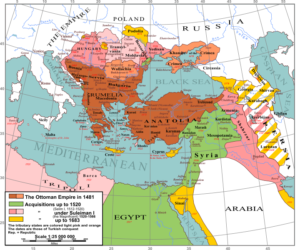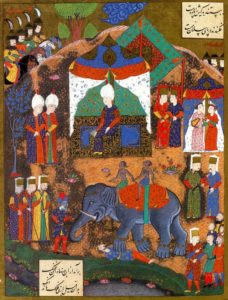Why don’t we like Sultan Suleiman?

There were three key rulers who had key roles during the age when Hungary was divided into two parts after the Battle of Mohács: Suleiman, Ferdinand, and Szapolyai. It was also marking the first phase of the Hungarian Renaissance built by King Matthias Corvinus…

In fact, King Szapolyai had not much room to navigate his country as he was equally threatened from the West and from the East.

Let us take Suleiman first into account as it was him, after all, who had attacked Hungary.
Sultan Suleiman I was called the Magnificient (ruled 1520-1566), he was an outstanding ruler who made the Ottoman Empire great.
However great law-giver and righteous ruler he was in his own home, here, in Hungary, Suleiman is said to have made even bigger damage in Hungary than the Mongolian invasion in 1241, perhaps only the Habsburgs could be compared to him.

Right from the fall of Nándorfehérvár / Belgrade in 1521, Suleiman had evaluated the situation very well and used the inviting opportunity to take revenge for the failure of his great-grandfather Sultan Mehmed II who had been defeated by Hunyadi János.
According to Kulcsár Árpád, a Hungarian historian, there are ten facts about why millions of Hungarians should not celebrate the Suleiman Series on TV. (Please, note that I use the Oriental name order for Hungarians where family names come first.)
Here are the ten points listed by Kulcsár against the Sultan:

1. He was the one who finished the sovereign Hungarian Kingdom off by causing the death of King Louis I at Mohács in 1526 so the Hungarian independence was given a staggering blow and it was how Habsburgs were able to gain power.

2. No other ruler of the enemy could ever destroy the country for so long, for 45 years. Suleiman had led seven campaigns against Hungary between 1521-1566 and he even finished his life there. Hundreds of villages were burned and flourishing towns were destroyed, thousands were taken to captivity.

3. Huge damage was done to human lives according to contemporary sources, whole areas got depopulated. By the end of the Ottoman wars in 1699, an estimated one million Hungarian people (civilians and soldiers alike) were killed or taken away. A whole Hungarian spoken dialect disappeared from the country; countless Renaissance and Gothic-style buildings, artifacts, and documents, and books perished.

4. Kulcsár includes the „verbal insults” into his list, blaming Suleiman for using words about the Hungarians like „auspicious and dishonorable Hungarians” or „base damned ones”, „lecherous evils”, „villains living in false belief” and called the Hungarian soldiers „offals who befriend the Devil”.

5. The Sultan (my remark: like many Christian rulers, though) was making a show of executing the Christian captives. Márk Szkublics, the heroic defender of Zimony Castle was offered his life in case he embraced the Muslim faith in 1521 but when he refused it, the young Suleiman had him thrown before his elephant. Five years later, he had 2,000 captured soldiered beheaded on the field of Mohács.

6. According to the traditional Ottoman strategy, he was intentionally terrorizing the inhabitants by sending his Akindji and Tatar riders to raid, pillage, and burn the lands, to spread terror and fear among them before invading the territories. Here we can mention the example of the massacre in Pécs where 4,000 inhabitants were killed.

7. Having conquered the new lands, he was systematically ripping them off, taking away all the valuable properties from the castles and homes, not to mention the taxes he imposed on the newly occupied territories, thus contributing to the ruin of the country.

8. The timar system was a less developed feudal system than the European way of life. As a result of its introduction, the new Sipahi landowners squeezed all the money out of their domains because the new owners had no right to leave the lands to their children automatically and many Sipahis were appointed to own the lands only for a limited time. It has made all development hardly impossible.

9. The Sultan made Török Bálint, the foster father of the baby King János Zsigmond prisoner in 1541 by inviting him into his tent as a guest, and then he took Buda Castle by a trick, not keeping his word. (My remark: yet, in other cases, Suleiman honestly kept his given word better than any other Christian ruler in the area. Suleiman never went back on his word regarding King Szapolyai, always supported him against the Habsburgs, and left Szapolyai`s half-kingdom untouched by his raiders.)

10. Suleiman was the enemy of the local Christian faith as well, he banned the tolling of the bells and did not allow the renovation nor the new construction of the churches. (My remark: He could not reinforce this law everywhere in Occupied Hungary, though.) Many churches were turned into mosques and the Christian were called „kafirs”, second-class citizens who had to pay more taxes.

You can read more about ethnic changes due to the Ottoman wars here:
https://www.hungarianottomanwars.com/essays/ethnic-changes-in-hungary-due-to-the-ottoman-wars/
One thing is for sure, the Ottoman Empire delivered such a blow to the Hungarians which had its effect felt even in the 20th century. Yet, these wars of concern were not about Hungary alone; sadly, we just provided a battlefield for this. Europe’s future was on the stakes. When Habsburg Ferdinand attacked Hungary in 1527, the Habsburgs were gradually taking hold of Hungarian foreign affairs and military control to such a degree that has resulted in Hungary’s involvement in WWI. The serious ethnic losses we suffered because of the long and unbalanced fight against the Ottomans also contributed to the result of Hungary’s final partition. Had we not been forced to join Austria in WWI, we would not have lost 72% of our lands after 1918.

Dear Readers, I can only make this content available through small donations or by selling my books or T-shirts.
If you like my writings, please feel free to support me with a coffee here:
You can check out my books on Amazon or Draft2Digital, they are available in hardcover, paperback, or ebook:
https://www.amazon.com/dp/198020490X
or at https://books2read.com/b/boYd81


My work can also be followed and supported on Patreon: Become a Patron!http://Become a Patron!



